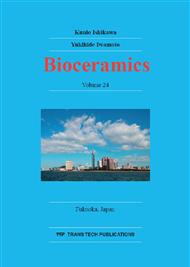[1]
L. Brandon-Peppas, J. O. Blanchette, Nanoparticle and Targeted Systems for Cancer Therapy, Adv. Drug Delivery Rev. 56 (2004) 1649−659.
DOI: 10.1016/j.addr.2004.02.014
Google Scholar
[2]
a) T. Yanagisawa, T. Shimizu, K. Kuroda, C. Kato, The Preparation of Alkyltrimethylammonium-Kanemite Complexes and Their Conversion to Microporous Materials, Bull. Chem. Soc. Jpn. 63 (1990).
DOI: 10.1246/bcsj.63.988
Google Scholar
[3]
K. B. Yoon, Electron- and Charge-Transfer Reactions within Zeolites, Chem. Rev. 93 (1993) 321−339.
DOI: 10.1021/cr00017a015
Google Scholar
[4]
K. Moller, T. Bein, Inclusion Chemistry in Periodic Mesoporous Hosts, Chem. Mater. 10 (1998) 2950−2963.
DOI: 10.1021/cm980243e
Google Scholar
[5]
M. Ogawa, Organized molecular assemblies on the surfaces of inorganic solids- photofunctional inorganic-organic supramolecular systems, Ann. Rep. Sec. C 94 (1998) 209−257.
DOI: 10.1039/pc094209
Google Scholar
[6]
A. Stein, B. J. Melde, R. C. Schroden, Hybrid Inorganic–Organic Mesoporous Silicates—Nanoscopic Reactors Coming of Age, Adv. Mater. 12 (2000) 1403−1419.
DOI: 10.1002/1521-4095(200010)12:19<1403::aid-adma1403>3.0.co;2-x
Google Scholar
[7]
B. J. Scott, G. Wirnsberger, G. D. Stucky, Mesoporous and mesostructured materials for optical applications, Chem. Mater. 13 (2001) 3140−3150.
DOI: 10.1021/cm0110730
Google Scholar
[8]
M. Ogawa, Photoprocesses in mesoporous silicas prepared by a supramolecular templating approach, J. Photochem. Photobiol. C Photochem. Rev. 3 (2002) 129−146.
DOI: 10.1016/s1389-5567(02)00023-0
Google Scholar
[9]
a) M. Tagaya and M. Ogaawa, Luminescence of tris(8-hydroxyquinoline)aluminum(III) (Alq3) adsorbed into mesoporous silica, Chem. Lett. 35 (2006).
Google Scholar
[10]
a) J. L. Vivero-Escoto, I. I. Slowing, C. W. Wu, V. S. Y. Lin, Photoinduced intracellular controlled release drug delivery in human cells by gold-capped mesoporous silica nanosphere, J. Am. Chem. Soc. 131 (2009).
DOI: 10.1021/ja900025f
Google Scholar
[11]
a) M. Tagaya, T. Ikoma, T. Yoshioka, T. Motozuka, F. Minami, J. Tanaka, Efficient synthesis of Eu(III)-containing nanoporous silicas, Mater. Lett. 65 (2011).
DOI: 10.1016/j.matlet.2011.04.011
Google Scholar
[12]
J. M. Rosenholm, A. Meinander, E. Peuhu, R. Niemi, J. E. Eriksson, C. Sahlgren, M. Lindn, Targeting of porous hybrid silica nanoparticles to cancer cells, ACS Nano 3 (2009) 197−206.
DOI: 10.1021/nn800781r
Google Scholar
[13]
a) E. Ruiz-Hitzky, P. Aranda, M. Darder, M. Ogawa, Hybrid and biohybrid silicate based materials: molecular vs. block-assembling bottom-up processes, Chem. Soc. Rev., 40 (2011).
DOI: 10.1039/c0cs00052c
Google Scholar
[14]
V. Sokolova, M. Epple, Synthetic pathways to make nanoparticles fluorescent, Nanoscale, 3 (2011) 1957−(1962).
DOI: 10.1039/c1nr00002k
Google Scholar
[15]
a) Y. Zhu, T. Ikoma, N. Hanagata, S. Kaskel, Rattle-type Fe3O4@SiO2 hollow mesoporous spheres as carriers for drug delivery, Small 6 (2010).
DOI: 10.1002/smll.200901403
Google Scholar
[16]
J. F. Kukowska-Latallo, K. A. Candido, Z. Cao, S. S. Nigavekar, I. J. Majoros, T. P. Thomas, L. P. Balogh, M. K. Khan, J. R. Baker, Nanoparticle targeting of anticancer drug improves therapeutic response in animal model of human epithelial cancer, Cancer Res. 65 (2005).
DOI: 10.1158/0008-5472.can-04-3921
Google Scholar
[17]
H. Tominaga, M. Ishiyama, F. Ohseto, K. Sasamoto, T. Hmamoto, K. Suzuki, M. Watanave, A water-soluble tetrazolium salt useful for colorimetric cell viability assay, Anal. Commun. 36 (1999) 47−50.
DOI: 10.1039/a809656b
Google Scholar
[18]
N. Wan, J. Xu, T. Lin, X. Zhang, L. Xu, Energy transfer and enhanced luminescence in metal oxide nanoparticle and rare earth codoped silica, Appl. Phys. Lett. 92 (2008) 201109−201111.
DOI: 10.1063/1.2936842
Google Scholar
[19]
E. J. Nassar, K. J. Ciuffi, S. J. L. Ribeiro, Y. Messaddeq, Europium incorporated in silica matrix obtained by sol-gel: luminescent materials, Mat. Res. 6 (2003) 557−562.
DOI: 10.1590/s1516-14392003000400023
Google Scholar
[20]
M. A. Zaitoun, T. Kim, C. T. Lin, Observation of Electron-Hole Carrier Emission in the Eu3+-Doped Silica Xerogel, J. Phys. Chem. B 102 (1998) 1122−1125.
DOI: 10.1021/jp972536l
Google Scholar
[21]
K. O. Yu, C. M. Grabinski, A. M. Schrand, R. C. Murdock, W. Wang, B. Gu, J. J. Schlager, S. M. Hussain, Toxicity of amorphous silica nanoparticles in mouse keratinocytes, J. Nanopart. Res. 11 (2009) 15−24.
DOI: 10.1007/s11051-008-9417-9
Google Scholar


